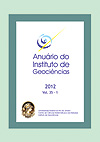Gondwana Geodiversity and Geological Heritage: Examples from the North Coast of São Paulo State, Brazil
DOI:
https://doi.org/10.11137/2012_1_101_111Abstract
The North Coast of São Paulo is marked by a geologic history related to the Western Gondwana supercontinent, amalgamated during the Brasiliano Cycle in the Neoproterozoic-Cambrian, and fragmented in the Jurassic-Cretaceous. Reactivations during the Cenozoic were also responsible for the current configuration of the Serra do Mar Mountain Range and the coastline. Moreover, the region holds the largest preserved area of Atlantic Forest in Brazil, which increases its importance as a protected zone. In addition to physical aspects records of history dating back 2500 years, as well as numerous buildings from the colonial period that tell a story of challenges between native peoples and conquerors occurred in the area. Together these features led to a rich culture, characterised by a mixture of customs of diverse traditional populations and that outlined the current cultural values. The aim of this work is to associate the main geological events that occurred during the Neoproterozoic-Paleogen, including merging and fragmentation of Gondwanaland and associated processes, to Geodiversity values. These actions are intended to include sites of recognised geoscientific value into local geotourism programs, including support for sustainability, preservation of history and traditional culture, integration of coastal population, and income generation.Downloads
Download data is not yet available.
Downloads
Published
2012-06-01
How to Cite
Garcia, M. da G. M. (2012) “Gondwana Geodiversity and Geological Heritage: Examples from the North Coast of São Paulo State, Brazil”, Anuário do Instituto de Geociências. Rio de Janeiro, BR, 35(1), pp. 101–111. doi: 10.11137/2012_1_101_111.
Issue
Section
não definida
License
This journal is licensed under a Creative Commons — Attribution 4.0 International — CC BY 4.0, which permits use, distribution and reproduction in any medium, provided the original work is properly cited.















